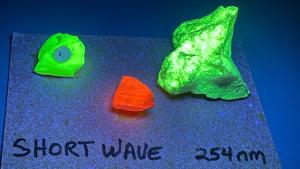Some minerals glow (fluoresce) when exposed to UV light. Certain minerals contain impurities called "activators" (such as Mn2+ and Pb2+) that absorb UV light. This causes electrons in the material to become excited to higher energy levels. Some of the electron's energy is lost as heat during excitation due to collisions and vibrations. When the electron returns to the ground state, for certain minerals, visible light is emitted (due to the energy loss), causing it to glow.
The color of the glow depends on the wavelength of the incoming UV light, the presence of trace elements inside the mineral and the purity and crystal structure of the sample.
Common fluorescent minerals:
Fluorite - blue or violet
Calcite - red, pink, orange or yellow
Willemite - bright green
Scheelite - blue-white
Sodalite - orange or yellow
Autunite - greenish yellow
254nm UV light, 365nm UV light, 254nm mineral samples, 365nm mineral sample
Basic UV safety. Don't shine the UV light at living things.

